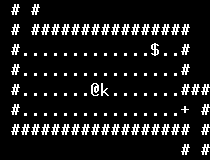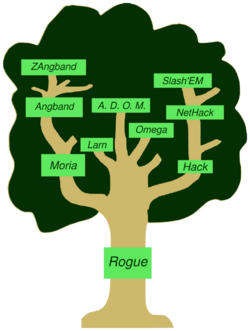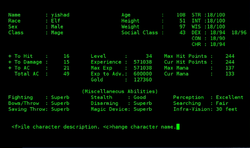Software:Moria (video game)
 Screenshot from a Moria-like game | |
| Developer(s) |
|
|---|---|
| Initial release | 25 March 1983 (0.1) |
| Stable release | 5.6
/ 13 October 2008[1] |
| Operating system | Cross-platform |
| Available in | English |
| Type | Roguelike |
| License | GNU General Public License v2 |
| Website | http://remarque.org/~grabiner/moria.html |
The Dungeons of Moria, or just Moria, is a roguelike computer game inspired by J. R. R. Tolkien's novel The Lord of the Rings. The game's objective is to kill a Balrog, presumably Durin's Bane, deep within the Mines of Moria. A later port of Moria called Umoria (UNIX Moria) inspired the Angband roguelike game. This game influenced the preliminary design of Blizzard Entertainment's Diablo.[2]
History

The original version was started at the University of Oklahoma by Robert Alan Koeneke after he became hooked on Rogue but could not run it on the VAX-11/780 minicomputer to which he had access.[4]
Koeneke started developing Moria in 1981[5] using the VMS BASIC programming language, but then rewrote it in VMS Pascal during the summer of 1983.[5] Jimmey Wayne Todd Jr. joined Koeneke on the continued development of the game from 1984.[4] In 1985 the source code was widely distributed under a license that permitted sharing and modification but not commercial use.
The last VMS version was Moria 4.8, released in November 1986.
James E. Wilson continued development of the game in 1987 with Umoria,[6] a modified version written in the C programming language for UNIX and MS-DOS, and which was later ported to many other computer systems including the Amiga, Atari ST and Apple IIGS.
In 2008, through the work of the free-moria project,[7][3] Umoria was relicensed under the GNU General Public License. Jimmey Wayne Todd Jr., a major contributor to VMS Moria, is not listed as consenting to the relicense.
The current maintainer of Moria is David Grabiner.
Gameplay
Moria begins with creation of a character. The player first chooses a "race" from the following: Human, Half-Elf, Elf, Halfling, Gnome, Dwarf, Half-Orc, Half-Troll. Racial selection determines base statistics and class availability. One then selects the character's "class" from the following: Warrior, Mage, Priest, Rogue, Ranger, Paladin. Class further determines statistics, as well as the abilities acquired during gameplay. Mages, Rangers, and Rogues can learn magic; Priests and Paladins can learn prayers. Warriors possess no additional abilities.
The player begins the game with a limited number of items on a town level of six shops: (1) a General Store, (2) an Armory, (3) a Weaponsmith, (4) a Temple, (5) an Alchemy shop, and (6) a Magic-Users store. A staircase on this level descends into a series of randomly generated underground mazes. Deeper levels contain more powerful monsters and better treasures. Each time the player ascends or descends a staircase, a new level is created and the old one discarded; only the town persists throughout the game.
As in most roguelikes, it is impossible to re-load from a save if your character dies, as the game saves the state only upon exit, preventing save-scumming that is a key strategy in most computer games that allow saving.
The balrog (represented by the upper-case letter B) is encountered at the deepest depths of the dungeon. Once the balrog has been killed, the game has been won, and no further saving of the game is possible.
Player characteristics
The player has many characteristics in the game. Some characteristics like sex, weight and height cannot be changed once the player has been created, while other characteristics like strength, intelligence, and armor class can be modified by using certain items in a particular way. Mana and hit points are replenished by rest or by some other magical means. Gold accrues as the player steps on gems or currency. Experience accrues as the player performs various actions in the dungeon, mostly by killing creatures. The "miscellaneous abilities" are modified as each skill is performed and as the player increases in experience.
See also
- List of open source games
References
- ↑ "Moria". RogueBasin. http://www.roguebasin.com/index.php?title=Moria. Retrieved 2017-08-29.
- ↑ "[The idea for Diablo] was modified over and over until it solidified when [Dave Brevik] was in college and got hooked on … Moria/Angband." Pitts, Russ (2006-06-06). "Secret Sauce: The Rise of Blizzard". The Escapist. http://www.escapistmagazine.com/articles/view/issues/issue_48/289-Secret-Sauce-The-Rise-of-Blizzard. Retrieved 2012-12-20.
- ↑ Jump up to: 3.0 3.1 Freeing an old game by Ben Asselstine on Free software magazine (2007-03-12)
- ↑ Jump up to: 4.0 4.1 "…I worked on one of the early VAX 11/780s [so] no more games, and no more rogue! This was intolerable! So I decided to write my own rogue game, Moria Beta 1.0." Koeneke, Robert Alan (1996-02-21). "Early history of Moria". https://groups.google.com/d/msg/rec.games.roguelike.angband/gFiS2tV_-AA/Gp7g-TfuJmUJ. Retrieved 2017-08-03.
- ↑ Jump up to: 5.0 5.1 "Breaking ground in 1981, Koeneke built on the foundations of Rogue..." Craddock, David L. (5 August 2015). "Chapter 7: None Shall Pass - Braving the Mines of Moria". Dungeon Hacks: How NetHack, Angband, and Other Roguelikes Changed the Course of Video Games. Press Start Press. p. 246. ISBN 978-0692501863.
- ↑ "Here it is! A Unix version of the popular VMS game Moria" Wilson, James E. (1987-11-05). "Umoria - single player dungeon simulation". https://groups.google.com/forum/#!searchin/comp.sources.games/umoria/comp.sources.games/kSX-_emh0Xs/9cX4kCaZa0EJ. Retrieved 2017-08-28.
- ↑ "free-moria". http://free-moria.sourceforge.net/.
External links
- Umoria.org v5.7 Windows / macOS executables, lots of historical information, and links to source code.
- Free Software Magazine - Freeing an old game discusses efforts to relicense UMoria
- Moria at MobyGames
- MS-DOS Moria can be played for free in the browser at the Internet Archive
- Beej's Moria Page
- Online VMS/VAX Moria telnet portal
- jsMoria, a JavaScript online version


